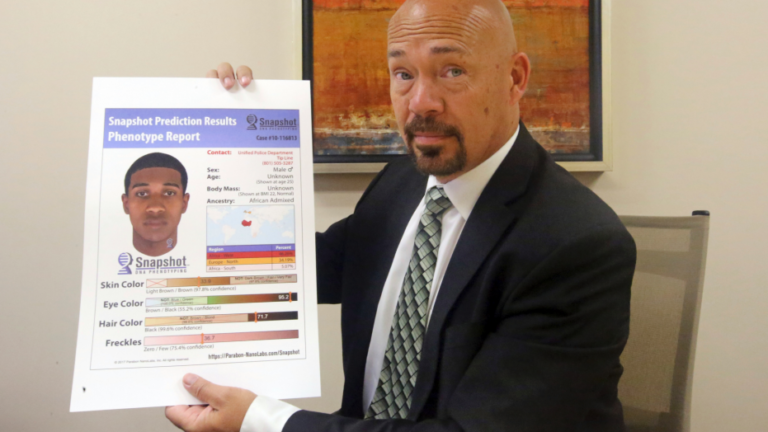A microscopic thread of DNA evidence in a public genealogy database led California authorities to declare this spring they had caught the Golden State Killer, the rapist and murderer who had eluded authorities for decades.
Emboldened by that breakthrough, a number of private investigators are spearheading a call for amateur genealogists to help solve other cold cases by contributing their own genetic information to the same public database. They say a larger array of genetic information would widen the pool to find criminals who have eluded capture.
The idea is to get people to transfer profiles compiled by commercial genealogy sites such as Ancestry.com and 23andMe onto the smaller, public open-source database created in 2010, called GEDmatch. The commercial sites require authorities to obtain search warrants for the information; the public site does not.
But the push is running up against privacy concerns.
“When these things start getting used by law enforcement, it’s very important that we ensure that to get all of the benefit of that technology we don’t end up giving up our rights,” said American Civil Liberties Union legal fellow Vera Eidelman.
She argues that when someone uploads their own DNA profile they aren’t just adding themselves — they’re adding everyone in their family, including dead relatives and those who haven’t been born yet. She also said DNA mining could lead to someone’s predisposition to mental and health issues being revealed.
“That one click between Ancestry and 23andMe and GEDmatch is actually a huge step in terms of who has access to your information,” Eidelman said.
This month, DNA testing service MyHeritage announced that a security breach revealed details about over 92 million accounts. The information did not include genetic data but nonetheless reinforced anxieties.
Nevertheless, the effort is gaining steam with some genetic genealogy experts and investigators.
The shared DNA profiles “could end up being the key to solving one of these cold cases and getting the family closure and getting someone really dangerous off the streets,” said CeCe Moore, the head of the genetic genealogy unit at the DNA company Parabon NanoLabs.
She’s uploaded her personal genetic information to the public database and wants it to become a larger repository of information for genealogy hobbyists and investigators alike. Separately, Parabon NanoLabs has also uploaded DNA data from 100 unsolved crime scenes in hopes of finding suspects.
Genetic genealogy has traditionally been used to map family histories. Labs analyze hundreds of thousands of genetic markers in an individual’s DNA, compare them with others and link up families based on similarities. The public database was created to compare family trees and genetic profiles between the commercial sites, which don’t cross-reference information.
Its potential as a police tool wasn’t broadly known until the April arrest of Golden State Killer suspect Joseph DeAngelo in northern California. Prosecutors allege DeAngelo, a former police officer, is responsible for at least a dozen murders and about 50 rapes in the 1970s and ’80s.
But the DNA-assisted hunt that led to his arrest wasn’t flawless. It initially led authorities to the wrong man whose relative shared a rare genetic marker with crime-scene evidence. A similar thing happened when authorities used a different public DNA database to investigate a nearly two-decade-old Idaho murder in 2014.
In May, Moore used the public database to help police arrest a 55-year-old Washington man linked to the 1987 killing of a young Canadian couple. She suspects the method will lead to dozens of arrests in similar cold cases.
Courts haven’t fully explored legal questions around the technique but are likely to allow it based on current law, said attorney and forensic consultant Bicka Barlow. The theory is that an individual’s right to privacy does not extend to material they’ve abandoned, whether it’s DNA or trash.
GEDmatch co-creator Curtis Rogers was initially unaware police used his site to find the suspected Golden State Killer. He’s glad it’s led to solving crimes but is worried about privacy issues. The site’s policy was updated in May and says it can’t guarantee how results will be used. Users are allowed to remove their information.
A California-based group of volunteers called the DNA Doe Project has also used the database to identify two bodies that stumped authorities for more than a decade. The group encourages its thousands of online supporters to contribute to the public database.
“It’s free, it’s like three or four clicks and a couple minutes of your time,” said co-founder Margaret Press. “It’s altruistic if you have no interest in your own family history; if you did, it’s a win-win.”
A volunteer group of investigators and attorneys called the Utah Cold Case Coalition has made a similar appeal.
The idea may be particularly appealing in Utah, co-founder Jason Jensen suspects. An interest in genealogy is especially strong in the state, because tenets of The Church of Jesus Christ of Latter-day Saints emphasize the importance of family relationships in the afterlife.
“Arguably that one person can post up their DNA and might potentially break a case that somebody back in Nantucket (Massachusetts) is trying to solve,” Jensen said.
(AP)











One Response
Interesting stuff